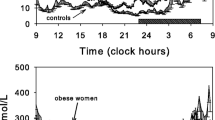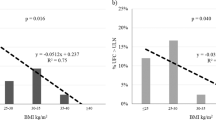Abstract
Patients with simple exogenous obesity are characterized by increased B-endorphin (B-EP) plasma levels, despite normal ACTH and B-Lipotropin (B-LPH). To evaluate the origin of such an hyperendorphinemia, 42 obese patients were submitted to a short overnight dexamethasone suppression test (DST: 1 mg at 23:00 h). Blood samples were taken in basal conditions and 9, and 17 h after DST. The same procedure was applied in 12 healthy, normal weight volunteers. In further five patients, 0.5 mg per 4/die were given. B-EP was measured by radioimmunoassay (RIA) after silicic acid extraction and Sephadex G-75 column chromatography. ACTH and Cortisol were measured by direct IRMA and RIA, respectively. Basal B-EP levels of patients (24.2 ± 16.5, fmol/ml, M ± SD) were double than in normal weight controls (10.8 ± 4.6), while ACTH and cortisol fell in the normal range. ACTH and cortisol were significantly reduced by DST in both patients and controls, while B-EP in patients did not. Cortisol, however, was not suppressed in 7 patients (16%). At 08:00, the suppression of B-EP in controls was 49.0 ± 18.4%, while in obese patients it was only 21.2 ± 38.8% (p < 0.01). However, patients with weight excess below 50% normally suppressed B-EP (41.6 ± 15.3%), while those with weight excess over 75% did not (11.3 ± 47.5%). The doubling of dexamethasone intake does not lead to a suppression of plasma B-EP in these last patients. These data indicate the existence of neuroendocrine abnormalities in the hypothalamus-pituitary-adrenal axis of obese patients and suggest that their hyperendorphinemia originates outside the anterior pituitary.
Similar content being viewed by others
References
Genazzani A.R., Facchinetti F., Petraglia F., Pintor C., Corda R. Hyperendorphinemia in obese children and adolescents. J. Clin. Endocrinol. Metab. 62: 36, 1986.
Facchinetti F., Giovannini C., Barletta C., Petraglia F., Buzzetti R., Burla F., Lazzari R., Genazzani A.R., Scavo D. Hyperendorphinemia in obesity and relationships to affective state. Physiol. Behav. 36: 937, 1986.
Givens J.R., Wiedemann E., Andersen R.N., Kitabchi A.E. B-Endorphin and B-Lipotropin plasma levels in hirsute women: correlation with body weight. J. Clin. Endocrinol. Metab. 50: 975, 1980.
Getto C.J., Fullerton D.T., Carlson I.H. Plasma immunoreactive B-Endorphin response to glucose ingestion. Appetite 5: 329, 1984.
Fullerton D.T., Getto C.D., Swift W.J., Carlson I.H. Sugar, opioids and binge eating. Brain Res. Bull. 14: 673, 1985.
Imura H., Nakai Y., Nakao K., Oki S., Tanaka I., Jingami H., Yoshimasa T., Tsukada T., Ikeda Y., Suda M., Sakamoto M. Biosynthesis and distribution of opioid peptides. J. Endocrinol. Invest. 6: 139, 1983.
Genazzani A.R., Facchinetti F., Pintor C., Puggioni R., Parrini D., Petraglia F., Bagnoli F., Corda R. Proopiomelanocortin-related peptide plasma levels throughout prepuberty and puberty. J. Clin. Endocrinol. Metab. 57: 56, 1983.
Facchinetti F., Petraglia F., Nappi G., Parrini D., Martignoni E., Antoni G., Genazzani A.R. Different pattern of central and peripheral endorphins through life. Peptides 4: 744, 1983.
Brambilla F., Genazzani A.R., Facchinetti F., Parrini D., Petraglia F., Sacchetti E., Scarone S., Guastalla A., D’Antona N. B-Endorphin and B-Lipotropin plasma levels in chronic schizophrenic primary affective disorders and secondary affective disorders. Psychoneuroendocrinogy 6: 321, 1981.
Carroll B.J., Feinberg M., Greden J.F., Tarika J., Albala A.A., Haskett R.F., James N.M., Kronfol Z., Lohr N., Steiner M., De Vi J.P., Young E. A specific laboratory test for the diagnosis of melancholia standardization, validation, and clinical utility. Arch. Gen. Psychiatry 38: 15, 1981.
Facchinetti F., Livieri C., Petraglia F., Cortona L., Severi F., Genazzani A.R. Dexamethasone fails to suppress hyperendorphinemia of obese children. Acta Endocrinol. (Kbh.) 116: 90, 1987.
Cohen M.R., Pickar D., Cohen R.M., Wise T.N., Cooper J.N. Plasma cortisol and B-Endorphin immunoreactivity in human obesity. Psychosom. Med. 46: 454, 1984.
Orwoll E.S., Kendall J.W. B-Endorphin and adrenocorticotropin in extrapituitary sites: gastrointestinal tract. Endocrinology 107: 438, 1980.
Bruni J.F., Watkins W., Yen S.S.C. B-Endorphin in human pancreas. J. Clin. Endocrinol. Metab. 46: 649, 1979.
Scavo D., Facchinetti F., Barletta C., Petraglia F., Buzzetti R., Giovannini C., Genazzani A.R. Plasma B-Endorphin in response to oral glucose tolerance test in obese patients. Horm. Metab. Res. 19: 204, 1987.
Reid R.L., Yen S.S.C. B-Endorphin stimulates the secretion of insulin and glucagon in humans. J. Clin. Endocrinol. Metab. 52: 592, 1981.
Feldman M., Kiser R.S., Unger R.H., Li C.H. Beta-Endorphin and the endocrine pancreas. N. Engl. J. Med. 318: 349, 1983.
Levine A.S., Morley J.E., Gosnell B.A., Billington C.J., Bartness T.J. Opioids and consummatory behavior. Brain Res. Bull. 14: 663, 1985.
Yim G.K.W., Lowy M.T. Opioids, feeding, and anorexias. Fed. Proc. 43: 2893, 1984.
Cooper S.J. Endophinergic mechanisms in food, salt and water intake: an overview. Appetite 5: 1, 1984.
Genazzani A.R., Nappi G., Facchinetti F., Mazzarella L.G., Parrini D., Sinforiani E., Petraglia F., Savoldi F. Central deficiency in alcohol addicts. J. Clin. Endocrinol. Metab. 55: 583, 1982.
Facchinetti F., Volpe A., Nappi G., Petraglia F., Genazzani A.R. Impairment of adrenergic-induced proopiomelanocortinrelease in heroin addicts. Acta Endocrinol. (Kbh.) 108: 1, 1985.
Petraglia F., D’Ambrogio G., Comitini G., Facchinetti F., Volpe A., Genazzani A.R. Impairment of opioid control of luteinizing hormone secretion in menstrual disorders. Fertil. Steril. 43: 534, 1985.
Amsterdam J.D., Winokur A., Caroff S.N., Conn J. The dexamethasone suppression test in outpatients with primary affective disorder and healthy control subjects. Am. J. Psychiatry 139: 287, 1982.
Holsboer F., Bender W., Benkert O., Klein H.E., Schmauss M. Diagnostic value of dexamethasone suppression test in depression. Lancet 2: 706, 1980.
Bueno J.A., Sabanes F., Gascon J., Gasto C., Salamero M. Dexamethasone suppression test in patients with panic disorder secondary depression. Arch. Gen. Psychiatry 41: 723, 1984.
Gwirtsman H.E., Roy-Byrne P., Yager J., Gerner R.H. Neuroendocrine abnormalities in bulimia. Am. J. Psychiatry 140: 559, 1983.
Author information
Authors and Affiliations
Rights and permissions
About this article
Cite this article
Facchinetti, F., Giovannini, C., Petraglia, F. et al. Plasma B-endorphin resistance to dexamethasone suppression in obese patients. J Endocrinol Invest 11, 119–123 (1988). https://doi.org/10.1007/BF03350117
Received:
Accepted:
Published:
Issue Date:
DOI: https://doi.org/10.1007/BF03350117




